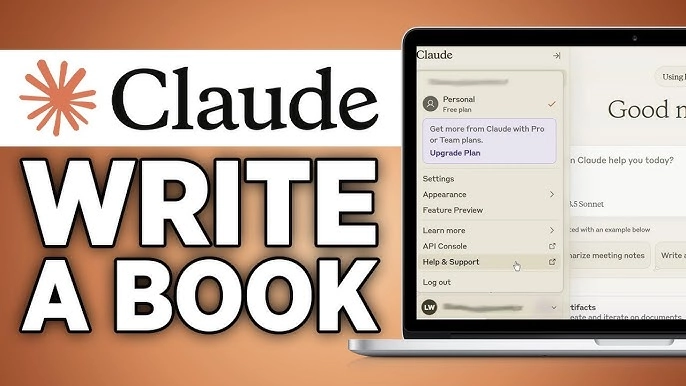Claude has evolved from novelty to necessity for many authors. Whether you craft sweeping fantasy sagas or tightly argued non-fiction, the newest Claude 4 family (Opus 4 & Sonnet 4) offers long-context reasoning, custom “Styles,” and a project-based memory that finally makes AI feel like a genuine co-writer. This guide distills real-world experience and mid-2025 best practice to help you harness Claude AI for writing books—efficiently, ethically, and without losing your unique voice.

Why Choose Claude AI in 2025?
Claude’s June 2025 edge comes from three pillars:
-
Massive context window (200 K-1 M tokens) keeps entire manuscripts in active memory.
-
Styles & Artifacts give you granular control over tone and a side-panel workspace for drafts, outlines, and story bibles.
-
Safety-first design (Constitutional AI) reduces toxic or off-brand outputs while still delivering vivid prose.
Quick Model Snapshot
Below is a condensed reference table authors keep pinned beside their desk:
| Model | Stand-out Strengths | Context Window | Best Use for Authors |
|---|---|---|---|
| Opus 4 | Deep reasoning, rich prose | 200K–1M tokens | Complex novels, research-heavy non-fiction |
| Sonnet 4 | Fast, aesthetic generation | 200K tokens | Daily drafting, dialogue, quick edits |
| 3.5 Sonnet | Vision + solid reasoning | 200K tokens | Image-based research, data-driven non-fiction |
| 3.5 Haiku | Speed & low cost | 200K tokens | Brainstorm bursts, first-pass copy-edit |
Setting Up a Claude-Powered Writing Workflow
Prerequisites
-
Claude account or API key (Opus for depth, Sonnet for speed).
-
Project folder with outline, character sheets, or research PDFs to feed Claude.
-
Optional integrations—Novelcrafter, Obsidian scripts, or Google Docs via AiAssistWorks—to keep everything in one place.
Core Workflow Stages
-
Brainstorm & Pitch – Seed ideas; Claude returns three high-concept hooks with moral stakes.
-
Outline & Story Beats – Break the winner into act structure, then granular beats.
-
Chapter Drafting – Generate 1 000-word scene drafts inside an Artifact; refine iteratively.
-
Revision Loop – Paste your edits back; instruct Claude to learn and tighten style.
-
Final Polish – Use Haiku for rapid grammar sweeps; Opus for tone consistency pass.
Step-by-Step—From Idea to Finished Manuscript
1. Brainstorm Without Blandness
Prompt example:<context>Terraformed Mars noir</context> <instructions>Pitch three plots with unique tech and moral dilemma.</instructions>
Claude’s wide context lets you stack background notes so pitches stay fresh, not generic.
2. Build a Living Outline
-
Ask for a three-act synopsis.
-
Convert to chapter grid—one-sentence goal, conflict, twist per chapter.
-
Feed back your tweaks so Claude updates its internal map.
3. Develop Deep Characters
Request a sheet covering flaw, fear, arc, and trope to subvert. Then run dialogue drills:
INSTRUCTION: "Write a tense 200-word exchange between Elara and the mentor,
dripping with subtext about trust."
4. Draft in Manageable Chunks
Generate 800-1 200 words at a time to minimize drift. Use the “Styles” panel to lock voice:
STYLE: Gritty first-person, sensory, scarce adverbs.
5. Iterate, Don’t Abdicate
After each human pass, tell Claude what you changed and why. This “teach-back” loop sharpens subsequent suggestions and prevents creative atrophy.
Advanced Prompting Techniques That Matter
Chain-of-Thought Directives
Guide Claude step-by-step: “First list possible misdirections; next decide the most impactful; finally draft the reveal scene.”
XML Tagging for Clarity
Separate long context into clear buckets:
<context>Series bible excerpt…</context>
<style_guide>Minimalist noir voice…</style_guide>
<task>Rewrite Chapter 7 for pacing</task>
Negative Constraints
“Do not resolve central mystery; avoid info-dump exposition; keep sentence length under 25 words.”
Integrations & Tools to Supercharge Claude
-
Novelcrafter – one-stop fiction studio with voice-matching and saved prompts.
-
Obsidian + Claude Code – turn vault notes into draft paragraphs or recap inconsistent lore.
-
Yomu AI – automate citations and plagiarism checks for academics.
-
Sudowrite – quick “sensory rewrite” passes before pulling text back into Claude for context coherence.
Ethical, Legal & Creative Considerations
-
Fact-check relentlessly—Claude can hallucinate.
-
Disclose AI assistance; many publishers now require it.
-
Watch for style dilution—use custom “Styles” and heavy human edits to preserve your voice.
-
Avoid over-reliance; keep brainstorming muscles active.
-
Monitor copyright developments; lawsuits over training data remain unresolved.
Conclusion—Your Voice, Amplified
Claude AI is not a ghostwriter; it’s a jetpack for disciplined authors. By combining its vast memory, customizable style engine, and your own critical eye, you can brainstorm bolder plots, draft faster, and polish with precision—while staying unmistakably you. Ready to test a workflow stage? Open Claude, paste your outline, and watch the collaboration begin.
FREQUENTLY ASKED QUESTIONS (FAQ)
QUESTION: Can Claude 4 really handle my entire 100 000-word draft at once?
ANSWER: Yes—for Opus 4, a 200 K token window comfortably fits roughly 150 000 words. For best results, chunk uploads by chapter and keep a concise series bible pinned for quick reference.
QUESTION: How do I stop Claude from making my prose sound generic?
ANSWER: Train a custom “Style” with 2-3 k words of your polished writing, specify negative constraints (“no cliché similes”), and always perform a human tone pass before finalizing.
QUESTION: Is it safe to paste unpublished manuscripts into Claude?
ANSWER: Anthropic states that user data is not used to retrain public models, but you should still review their privacy policy and avoid uploading sensitive contractual or personal data.
QUESTION: Does Claude replace professional editors?
ANSWER: It replaces first-pass line edits and structural feedback loops, but experienced developmental and copy editors still provide nuanced insights, market awareness, and a second pair of human eyes.
QUESTION: Which Claude model is the most cost-effective for long series?
ANSWER: Draft with Sonnet 4 for speed and price, then migrate key chapters to Opus 4 when you need deep thematic or continuity checks before publication.
